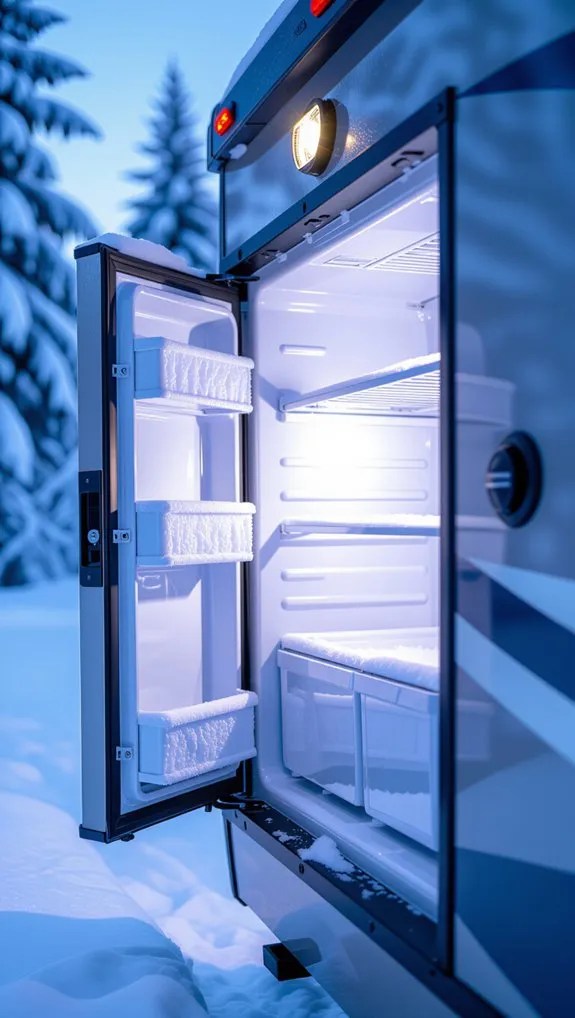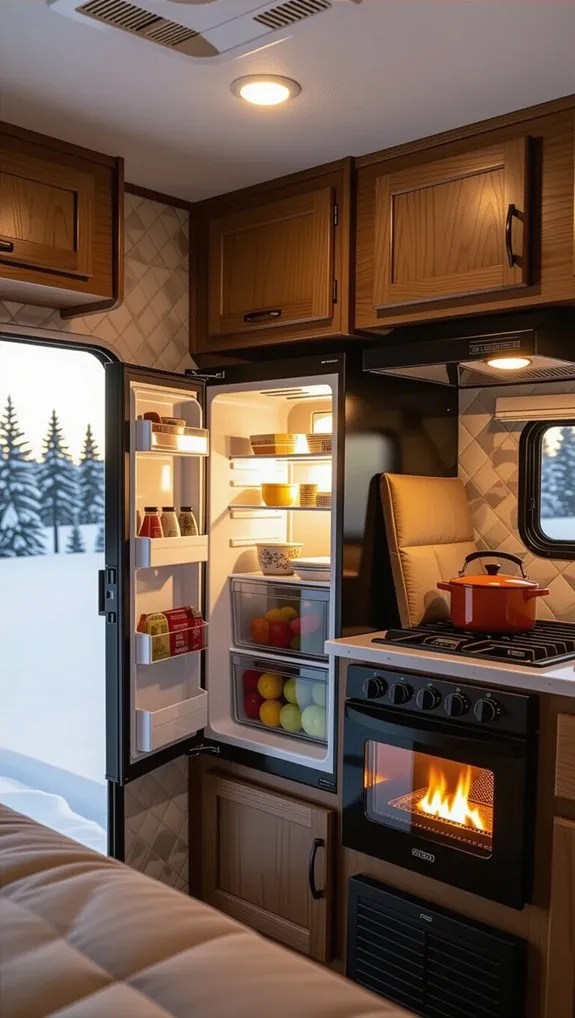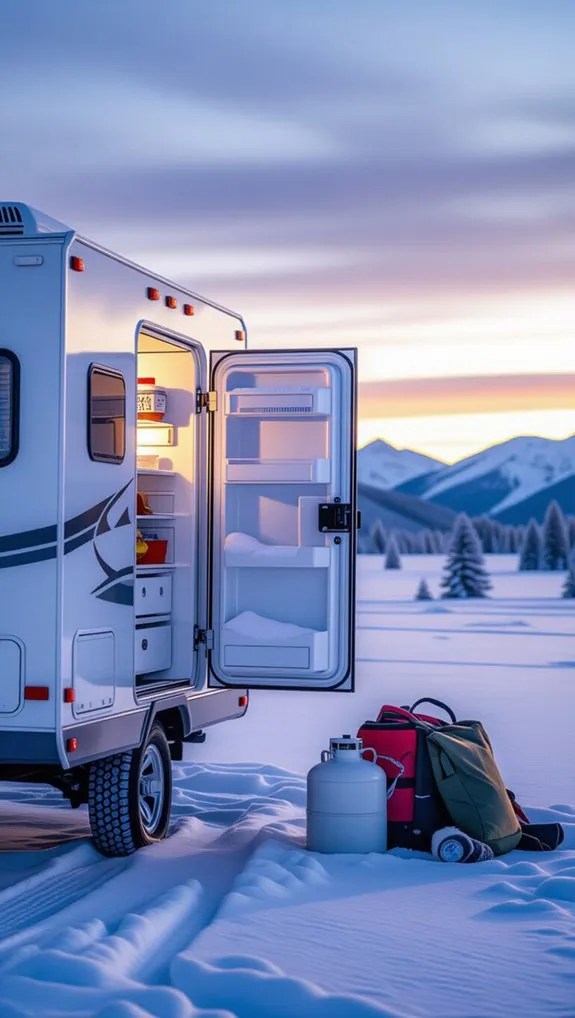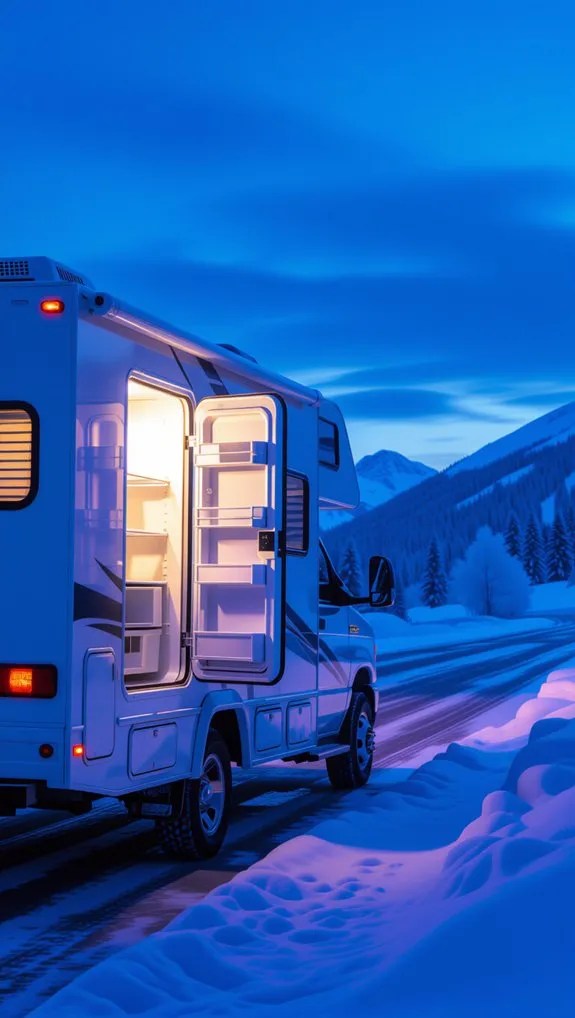Can you operate RV refrigerator in extreme cold weather? This question keeps many RV enthusiasts awake at night, especially when planning those gorgeous but frigid winter adventures. The short answer is yes, but it’s not always straightforward – and doing it wrong could leave you with spoiled food or a damaged cooling system.
Winter RVing presents unique challenges for your refrigerator, whether it’s absorption-based or compressor-driven. From understanding how sub-zero temperatures affect different fridge types to implementing practical winterization strategies, there’s more to cold-weather RV refrigeration than simply flipping the power switch.
In this guide, I’ll walk you through everything you need to know about running your RV fridge in extreme cold, including specific techniques for different refrigerator types, essential winterization steps, and troubleshooting tips that could save your next winter camping trip.
Operate RV refrigerator in extreme cold weather?

Operating an RV refrigerator in extreme cold weather can quickly turn into a chilling challenge for many road travelers.
Your best bet is a compressor fridge, which handles low temperatures far better than absorption units. These resilient coolers can often operate down to 0°F, maintaining food safety and preventing costly spoilage.
However, you’ll want to check your specific model’s low-ambient rating, as performance can vary.
Reliable 12V power becomes crucial in winter, so ensure your battery is well-charged and consider adding a cold-weather kit for consistent refrigeration during those frosty adventures.
What temperatures are too cold for absorption?
When temperatures plummet, absorption RV refrigerators can quickly become unreliable cooling companions. Grasping the cold-weather limits is crucial for RV owners.
| Temperature Range | Absorption Fridge Performance |
|---|---|
| Above 32°F | Normal Operation |
| 20-32°F | Reduced Efficiency |
| Below 20°F | High Risk of Failure |
Absorption fridges struggle below 32°F, with performance drastically declining around 20°F. Most manufacturers warn against operating in sub-freezing conditions, as the cooling mechanism becomes ineffective. Cold temperatures can cause gelging, freezing internal components, and potentially damaging the refrigerator. Some models offer low-temperature kits with heating elements to extend reliable operation, but caution is always recommended.
Does a compressor RV fridge handle freezing?

Although absorption refrigerators struggle in freezing temperatures, compressor RV fridges offer a more robust cooling solution for cold-weather travelers.
Most compressor fridges can handle temperatures down to 14°F (-10°C), maintaining reliable cooling performance. They’re engineered to operate efficiently in challenging conditions, with many models rated for extreme cold environments.
The key is monitoring internal temperatures and ensuring consistent power supply. I recommend checking your specific fridge’s low-ambient operating temperature range and taking precautions like maintaining good insulation, keeping door seals tight, and having a reliable power source to support consistent cooling performance.
Cold-weather risks for RV fridge systems
Cold-weather challenges can quickly turn your RV refrigerator from a reliable food preserver into a frustrating cooling failure if you’re not prepared. Absorption fridges are particularly vulnerable, with cooling performance dramatically dropping below 32°F. Adding a cold weather kit can help, but it’s not a complete solution.
Compressor models aren’t immune either—they struggle with low temperatures and require consistent power. Blocked vents, uninsulated compartments, and freezing ambient conditions can compromise refrigeration efficiency. Grasping these risks helps RV owners make smart choices, whether that means investing in specialized equipment or planning strategic winter travel routes.
How to prep RV fridge for cold

When prepping your RV fridge for cold weather, start by checking your vent covers to ensure they’re intact and properly positioned to manage airflow without blocking critical ventilation.
Next, carefully baffle the exterior compartment to reduce cold air infiltration while maintaining necessary condenser cooling, which helps prevent system strain during low-temperature conditions.
Don’t forget to inspect and potentially replace your door seals, as these small but crucial components can significantly impact your refrigerator’s ability to maintain internal temperature and efficiency in challenging winter environments.
Vent covers
Preparing your RV refrigerator’s vents can make or break its performance in cold weather. I recommend using insulated vent covers or foam inserts specifically designed for your model to reduce heat loss while maintaining critical airflow.
Carefully block two of three lower vent louvers, leaving enough space for ventilation. Never seal top vents completely, as the compressor needs air circulation to reject heat and prevent system damage.
When temperatures regularly drop below 20°F, consider a manufacturer’s cold-weather kit or a small controlled heat source near the refrigerator to keep the temperature inside stable and protect your cooling unit.
Baffle check
Because your RV fridge’s performance hinges on proper baffle maintenance, I’ll walk you through a critical cold-weather preparation checklist.
Carefully inspect the baffle/insulation kit around your RV fridge’s exterior and access panels to reduce heat loss.
Check that factory or aftermarket cold-weather baffles are correctly installed, ensuring they cover critical areas without blocking essential ventilation.
When temperatures approach 0–10°F, consider adding temporary exterior insulation behind vents.
Door seals
Door seals are often the unsung heroes of RV refrigerator performance, especially when Jack Frost comes knocking. Those door gaskets are critical for maintaining cold temperatures and preventing energy waste.
I recommend inspecting them regularly by closing a dollar bill around the perimeter—if it slides out easily, you’ve got a seal problem. Cleaning and conditioning the gaskets every 6–12 months keeps them flexible in sub-freezing temperatures.
Check hinge alignment and ensure the door closes completely, as even a tiny 1–2 mm gap can compromise cooling efficiency. Insider tip: consider adding a gasket heater for extra protection in extreme cold.
Do I need a fridge cold kit?

How do you know if a cold-weather kit is right for your RV fridge? For absorption refrigerators operating in low ambient temperatures, a cold-weather kit can be a game-changer.
If you’re camping where temps dip near or below freezing, this small 12V heater helps keep your cooling system reliable. Most Norcold models struggle below 32°F, so check your manual.
Compressor fridges typically handle cold better, but a kit might still help in prolonged sub-zero conditions. Before installing, confirm compatibility, follow manufacturer recommendations, and ensure you’ve got reliable 12V power to run the heater.
How to keep temps stable while parked
When you’re parked in cold weather, strategic thermometer placement becomes crucial for monitoring your RV fridge’s performance, so I recommend positioning a digital thermometer near the back wall where temperature fluctuations are most noticeable.
Your loading strategy can significantly impact cooling stability, so arrange items to allow maximum air circulation and pre-cool the unit before adding groceries.
I’ve found that comprehending your fridge’s run cycles helps you predict and manage temperature consistency, allowing you to adjust power sources and ventilation to maintain steady cooling even in challenging ambient conditions.
Thermometer placement
Strategic thermometer placement transforms your RV refrigerator’s performance, especially when battling extreme cold conditions.
Accurate ambient temperature monitoring is crucial for maintaining optimal cooling. I recommend placing one digital thermometer in the main fridge compartment and another in the freezer, positioning them mid-depth and mid-height away from doors and vents for true temperature readings.
For comprehensive tracking, add an exterior thermometer near the condenser panel to detect potentially damaging low temperatures. A second interior thermometer helps monitor living space heat influence, ensuring your fridge operates efficiently in challenging cold weather environments.
Load strategy
After meticulously tracking temperatures with strategically placed thermometers, the next critical step is mastering your RV refrigerator’s load strategy to maintain stable cooling during cold-weather stops.
I always pre-cool the fridge and freezer before parking, then strategically load high-heat-capacity items like water bottles and canned goods to create thermal mass. This helps slow temperature swings during power interruptions.
I’m careful to leave 1-2 inches of space around vents and avoid overpacking shelves, ensuring cold air circulates evenly. By thinking strategically about how I load my refrigerator, I can keep food consistently cool, even in challenging winter conditions.
Run cycles
Carefully managing your RV refrigerator’s run cycles becomes critical when temperatures plummet, as compressors struggle to maintain consistent cooling in extreme cold. A strategic approach keeps your food fresh and prevents system strain.
| Temp Range | Cycle Frequency | Recommended Action |
|---|---|---|
| Below 20°F | Rare/No Cycles | Add heat source |
| 20-40°F | Multi-hour Cycles | Monitor closely |
| Above 40°F | Normal Cycles | Standard operation |
Your fridge needs to be level to ensure proper cooling efficiency. I recommend using a small 60-75W heat source in the vent area and insulating exterior surfaces to stabilize run cycles and maintain consistent temperatures during cold weather camping.
Troubleshoot weak cooling in freezing weather
When your RV fridge starts struggling to keep things cool during freezing weather, you’ll want to zero in on potential cooling issues fast.
Make sure to check your voltage supply, ensuring it’s steady between 12–13.5 V.
Inspect condenser vents and door seals for potential airflow problems.
If cooling seems weak, try warming the fridge’s exterior with a heat lamp or sunlight.
Digital thermometers can help track internal temperatures, alerting you to performance drops.
Don’t let freezing temps compromise your food storage—quick troubleshooting can restore your refrigerator’s reliable cooling power.
When to switch to propane or electric

If your RV fridge isn’t cooling as expected in chilly weather, knowing when to switch between power sources can make all the difference.
Absorption fridges are designed to operate on propane when driving or without shore power, but they struggle below 32°F. In freezing conditions, switch to electric mode if you’ve got reliable battery, generator, or shore power.
Compressor fridges handle cold better, maintaining performance even near 0°F.
Always check your model’s specific low-ambient ratings and consider a cold-weather kit for absorption units to ensure reliable cooling on your winter adventures.
Storage tips after a polar cold snap
After weathering a polar cold snap, winterizing your RV refrigerator becomes a critical maintenance step that can save you from costly repairs and potential mold issues.
For your Norcold fridge, start by emptying and thoroughly defrosting all surfaces. Prop open cabinet doors, insert moisture-absorbing packets, and use a small fan to prevent dampness. Disconnect water lines and add RV-safe antifreeze if temperatures dipped below freezing.
Check your battery’s charge and store it in a warm place to avoid sulfation.
Don’t forget to inspect and lubricate door seals for optimal protection during storage.
Frequently Asked Questions
Does Outside Temperature Affect RV Refrigerator?
Yes, outside temperature drastically affects my RV fridge. Cold can disrupt absorption cooling cycles, and compressor units struggle in extreme temperatures. I’ve learned to use heating kits and manage ventilation to keep my refrigerator running efficiently.
Can You Run a Refrigerator in Cold Weather?
I can run a refrigerator in cold weather, but I’ll need to take precautions like adding insulation, ensuring good power supply, and checking my specific model’s low-temperature rating to prevent potential cooling malfunctions.
What Is the Most Common Problem With RV Refrigerators?
The most common problem I’ve seen with RV refrigerators is loss of cooling, often caused by improper leveling on absorption units, failing compressors, or electrical supply issues that prevent consistent temperature maintenance.
What Is the Safe Temperature for RV Refrigerator?
I recommend keeping your RV refrigerator between 32°F and 100°F for optimal performance. Most absorption fridges struggle below 32°F, while compressor models can handle slightly colder temps. Always check your manufacturer’s specific guidelines for your exact model’s safe temperature range.
In Conclusion
Conclusion
So, can you operate an RV refrigerator in extreme cold weather? Absolutely – with the right knowledge and preparation. Don’t let freezing temperatures freeze your RV refrigerator’s performance. By understanding your fridge type, preparing properly, and monitoring conditions consistently, you’ll keep food fresh and drinks cold throughout the harshest winter conditions. Whether you’ve got a compressor or absorption unit, smart preparation means reliable cooling when you need it most.
Always check manufacturer guidelines, invest in cold-weather protection kits if needed, and stay proactive about temperature management. Your RV kitchen can work smoothly, even when winter tries to challenge your cooling capabilities. For those considering an upgrade or replacement, check out our comprehensive RV refrigerator reviews to explore smart, well-reviewed options that excel in extreme weather conditions and offer the reliability every serious RVer demands.

